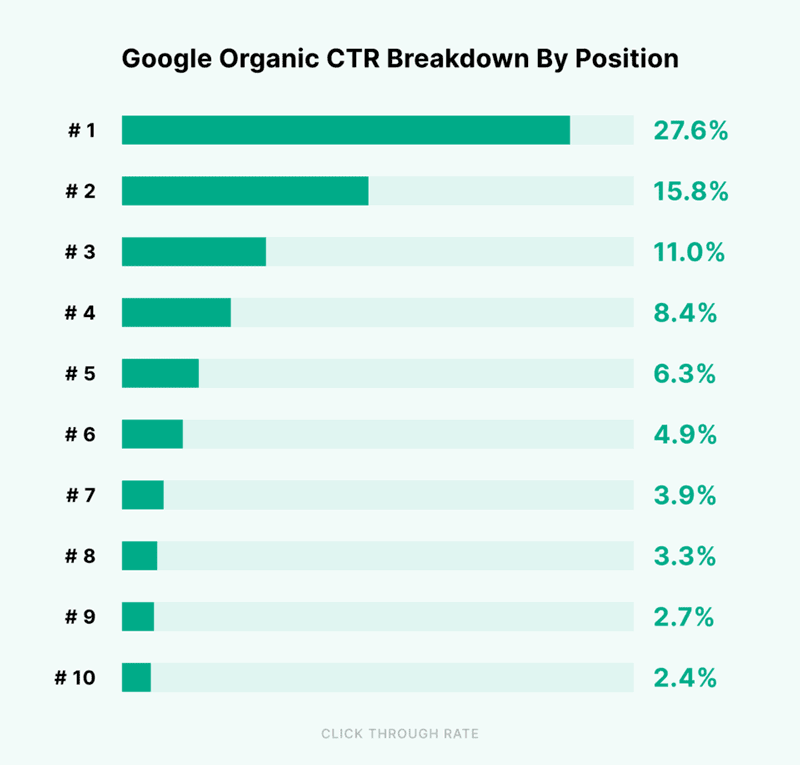Increasing organic traffic is the best way to boost your conversion rates. However, moving that needle isn’t easy if you can’t land on the first page of the search engine results pages.
According to Backlinko research, the top position on Google’s SERP has an average click-through rate of 27.6%. However, you won’t do too shabbily if you find yourself within the first 10 spots.

Source: Backlinko
How do you get to that first page to increase organic search traffic? You employ strategies that appeal to your audience and search engine algorithms. Let’s dig into eight content-driven ways to get more traffic to your site.
1. Create Content for Your Audience – Not Algorithms
Your audience should come first in your content strategy. Create engaging and relevant content for humans instead of search engines. People want to consume content that:
- Answers their questions
- Solves a problem or issue
- Provides valuable and relevant information
- Entertains them
You can’t influence bots without impressing your audience. Take time to understand your audience so that you can provide content with substance.
Another essential aspect of writing for humans is to sound like one in your content. Use language your viewers can relate to, but make sure it doesn’t stray from your brand’s voice, or you risk appearing inauthentic (and therefore untrustworthy).
2. Be Consistent in Your Content Production Cycle
Consistency is critical if you want to increase organic search traffic. Your audience (and, yes, the algorithms, too) develops expectations based on how much content you publish, when, and on what channels.
We know. Publishing consistently is hard. Establish a content strategy that identifies your content marketing goals and defines your publishing framework. A content calendar lets you stay on top of and track your production progress.
Here’s another time-saving tip: Repurpose existing content. Repackaging what you already have for a new platform or market is an efficient way to publish content consistently, and it’s good for SEO. We call that a win-win strategy.
3. Incorporate a Blog Into Your Marketing Strategy
Blogging is alive and well, contrary to what many believe. However, blogging has evolved. While it’s still an excellent storytelling venue, your blog needs to be intentional and serve your audience’s interests.
With an estimated 600 million blogs hanging out on the web, you must ensure your posts stand out from the other voices shouting to be heard. If you want to increase organic search traffic, incorporate the following into your blog:
- How-to posts and tutorials
- Case studies
- Original research
- Guides
- Trends and predictions
- Listicles
Long-form blogs are the way to go for organic traffic. However, keep your writing concise. If you can get your point across in 500 words, don’t try to double that with irrelevant or redundant fluff.
4. Include Visual and Video Elements
Add visual elements to your content. Incorporate photos, infographics, and videos into your website, landing pages, product pages, blogs, and social media posts. All three are easily shareable. Indeed, consumers share visual content more than textual content.
In 2022, 66% of people preferred video content over other formats, and 93% of businesses indicated that branded video content gave them new customers. If you want to increase search traffic, keep them under three minutes and make them entertaining, even if your topic is informational or instructional.

Source: Hubspot
5. Update Keyword Practices
You might be surprised that keywording wasn’t at the top of our list. People often focus on keywords, but we didn’t include it at the top because you should prioritize content substance before keyword strategy.
That said, incorporating keywords is still essential in 2023. A vital keyword consideration is search intent. The words and phrases you choose should reflect search intent and your blog’s content. A mismatch between the two will increase your bounce rate and earn ranking demotions.
A great way to increase organic search traffic using keywords is to choose long-tail over short-tail phrases. Long-tail phrases speak to a more specific audience.
Often searchers begin with a short-tail keyword, then refine their search by adding more specific terms to get the results they’re looking for. Long-tail keywords also tend to have less competition, allowing you to outshine other brands writing on the same topics.
6. Optimize Titles, Visuals, and Meta Description
SEO isn’t just for your content. Optimizing your titles, title tags, and meta descriptions with a keyword improves visibility in the search results as long as the content is relevant.
You can also add SEO tags to visual elements. Optimizing videos, photos, and graphics includes writing a caption describing the visual and containing your targeted keyword.
7. Aim for Featured Snippets
Another path for optimization that can increase organic search traffic is to format your content to make it featured-snippet-ready. Featured snippets are the boxes that appear at the top of the SERPs that provide concise, quick answers to search queries.
In addition to incorporating keywords into content that provide a direct answer, you should also use H2 and H3 headers that tell readers what to expect from the content that follows. You’ll notice that featured snippets often contain bulleted and numbered lists, so including them in your content is a great idea.
8. Include Internal Links
Internal links take people from one area of your website to another. They keep visitors on your site longer and tell the search engines that your site contains relevant content. Incorporating them is another way to ensure your top-performing pages continue to see traffic, and they can also revive pages that have slowed.
However, to effectively leverage internal links, you must send viewers to relevant and related content. You should verify that the linked content is high quality, optimized, and evergreen. Additionally, use anchor text that accurately conveys the subject matter viewers will find if they click the link.
Divvy Makes It Easier To Increase Organic Search Traffic
While we can’t create content for you that will instantly shoot you to the top of the SERPs, our platform simplifies and streamlines the content production process. We provide an intuitive, central hub that contains all the tools your team needs to plan, collaborate, create, and schedule amazing content so you can rise in the ranks.
Divvy Analytics also lets you measure and track progress to know when to pivot your strategy to increase organic search traffic. Request a demo today to discover how we help you focus on what’s important in content marketing.
